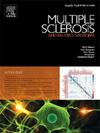Development and validation of a scoring system for predicting disease activity in treatment-naïve patients with relapsing-remitting multiple sclerosis
IF 2.9
3区 医学
Q2 CLINICAL NEUROLOGY
引用次数: 0
Abstract
Background
Relapsing-remitting MS (RRMS) exhibits significant heterogeneity and different treatment responses. Up to date, there is no international consensus on defining disease activity which foretells potential prognosis. This study aims to develop and validate a “Scoring System for Disease Activity Prognosis in Treatment-Naïve RRMS Patients” (DAPS-RRMS) to help guiding treatment decisions.
Methods
A set of clinical and radiological factors predicting RRMS disease activity based on an extensive literature review were identified. Real-world data from 520 treatment-naïve RRMS patients were extracted from the Egyptian MS registry dataset by independent neurologists and were disseminated among a group of MS experts for evaluation of each case separately. To convert this clinical impression into a validated score, ordinal logistic regression was used to develop the scoring system and nomogram; validation was conducted using Receiver Operating Characteristic (ROC); interrater reliability was assessed using Kendall's coefficient of concordance and the Intraclass Correlation Coefficient (ICC).
Results
According to cut off values based on the sum of scores of involved parameters, patients were classified into four categories predicting disease activity, “Active” (0–9), “Highly Active” (9.5–14), “Very Highly Active” (14.5–19), and “Aggressive” (>19). The scoring tool demonstrated excellent performance metrics with high inter-rater agreement (Kendall's W 0.764), and reliability including a high area under the curve (AUC) for discriminating between categories.
Conclusion
This validated scoring system provides a practical and reliable tool for predicting RRMS disease activity and guiding treatment decisions in treatment-naïve patients, particularly in resource-limited countries. The model is combined with a user-friendly nomogram.
求助全文
约1分钟内获得全文
求助全文
来源期刊

Multiple sclerosis and related disorders
CLINICAL NEUROLOGY-
CiteScore
5.80
自引率
20.00%
发文量
814
审稿时长
66 days
期刊介绍:
Multiple Sclerosis is an area of ever expanding research and escalating publications. Multiple Sclerosis and Related Disorders is a wide ranging international journal supported by key researchers from all neuroscience domains that focus on MS and associated disease of the central nervous system. The primary aim of this new journal is the rapid publication of high quality original research in the field. Important secondary aims will be timely updates and editorials on important scientific and clinical care advances, controversies in the field, and invited opinion articles from current thought leaders on topical issues. One section of the journal will focus on teaching, written to enhance the practice of community and academic neurologists involved in the care of MS patients. Summaries of key articles written for a lay audience will be provided as an on-line resource.
A team of four chief editors is supported by leading section editors who will commission and appraise original and review articles concerning: clinical neurology, neuroimaging, neuropathology, neuroepidemiology, therapeutics, genetics / transcriptomics, experimental models, neuroimmunology, biomarkers, neuropsychology, neurorehabilitation, measurement scales, teaching, neuroethics and lay communication.
 求助内容:
求助内容: 应助结果提醒方式:
应助结果提醒方式:


